We’re all bound to experience at least one type of the common benign skin growths in our lifetime. Thankfully, a majority of these growths are completely harmless. Beyond that, some of them are hardly even noticeable. But, if you don’t know what you’re looking for, or if something pops up on your body that concerns you, knowing how to identify it can be important.
The more we know about the differences in skin growths, the better. Some growths can indeed be harmful. Or, they can lead to more serious medical issues. However, that doesn’t always need to be your first assumption. Let’s take a closer look at some of the most common types of benign skin growths. When you know what they are, and how to identify them, you can have peace of mind.
Be aware that some of these growths are fairly unnoticeable, while others may look somewhat unnerving. Some are even frightening to people. Having any ‘growth’ showing up unexpectedly can cause us to startle. But, as long as you know what you might ‘have,’ you can at least take the proper treatment steps. You can then get rid of the growths relatively quickly. Let’s take a closer look at some of these common benign skin growths. Use this information to be more aware. Take notice of what might be going on with your skin at any given time.
Most Common Types of Benign Skin Growths
Skin Tags
Skin tags are nothing more than small flaps or folds of skin. They can be quite small, or they can grow to the size of a grape. Many, many people will experience skin tags in their lifetime, for various reasons. The most commonly-known reasons for skin tags have to do with friction. This can occur when skin rubs against skin, or against clothing or jewelry. The irritation can cause one to form. This is why they are found as small growths of skin on the neck or growths of skin under the armpit.
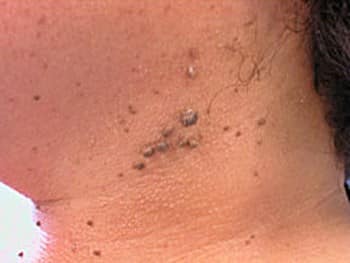
Typically, skin tags are completely harmless, but depending on where they are located, people may consider removal, due to cosmetic issues. Skin tags are notorious for forming on eyelids, or in small clusters. With that in mind, some people aren’t comfortable with the way they look. Thankfully, there are plenty of treatment options to consider. From medical procedures or over the counter medications, there are many ways to get rid of skin tags. They will not fall off on their own, no matter how long you have one. All skin tags require treatment if you choose to get rid of it.
Consider the fact that the best way to safely get rid of the tag is by cutting off its blood supply. This typically means ‘suffocating’ it somehow. There are plenty of treatment options, such as the TagBand device. So, whether you have one skin tag or a cluster, consider your treatment options.
Warts
Warts are not harmful, but they are considered to be a virus. They are usually described as fleshy raised bumps on the skin. However, there are a variety of classifications when it comes to warts, including flat, seed, mosaic, and more. Even though they are quite common, many people don’t know that much about warts in general. There are plenty of old tales that go along with them, and stereotypes about the kind of people who get them.
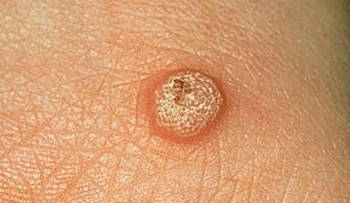 Warts are a result of HPV (human papillomavirus). When the virus comes into contact with open skin, it can create an infection and warts can occur. That’s why most warts tend to appear on cuts, broken skin, hangnails, etc. It’s easier for the virus to get through the top layer of skin that way. Children are especially susceptible to warts, as their immune system is usually weaker.
Warts are a result of HPV (human papillomavirus). When the virus comes into contact with open skin, it can create an infection and warts can occur. That’s why most warts tend to appear on cuts, broken skin, hangnails, etc. It’s easier for the virus to get through the top layer of skin that way. Children are especially susceptible to warts, as their immune system is usually weaker.
Like any virus, warts can be contagious. So, if you touch another part of your body that is exposed, you can expect warts to spread. Even touching surfaces that have been in contact with someone’s wart(s) can cause spreading. At times, it can seem impossible to avoid them. If you have a wart, it’s a good idea to try to remove anything from your life that has come into contact with it (i.e. a shaving razor, etc.). Make sure anything that comes into contact with the wart is clean and disinfected.
Treatment of warts can come from over-the-counter remedies to at-home solutions. Because warts are so common and so easy to pass from person to person, there are plenty of treatment options.
Here is an in-depth guide to the differences between skin tags and warts.
Moles
If you stopped and took a look at your body right now, you would notice several moles. You sometimes find a skin tag growing on a mole. While some people have more than others, most people have at least a few moles somewhere on their skin. They’re probably in different shades of darkness, and of different sizes. Moles are common and benign skin growths. You probably already know the importance of keeping an eye on moles, in general. If they change shape, size, or color, it can become a different story very quickly, and you should see a dermatologist.
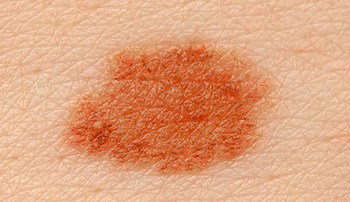 For the most part, however, moles are harmless. But, many people don’t know what they are, or what causes them. Simply put, they are small, benign growths on the skin that are usually brown or black. Most moles occur in the first 20 years of life (mostly as children). They are a part of your skin’s growth. When a cluster of skin cells forms together at the surface, it creates a mole. All of the cells together create a darker pigmentation. A mole, in this sense, is nothing more than a group of skin cells that didn’t spread out.
For the most part, however, moles are harmless. But, many people don’t know what they are, or what causes them. Simply put, they are small, benign growths on the skin that are usually brown or black. Most moles occur in the first 20 years of life (mostly as children). They are a part of your skin’s growth. When a cluster of skin cells forms together at the surface, it creates a mole. All of the cells together create a darker pigmentation. A mole, in this sense, is nothing more than a group of skin cells that didn’t spread out.
Over time, those pigmented dots will get lighter, thanks to age, and natural changes and growth in our skin. So, keep an eye on your moles, even as you age. The common fear with a lot of moles is skin cancer (melanoma). But, for the most part, there is no reason to assume that just because you have a mole – even quite a few, that melanoma is a large risk. Moles are more common than you might think. They are a skin growth practically everyone has, with very little risk involved, overall.
Seborrheic Keratoses
In what is commonly known as the most common benign tumor of the skin, seborrheic keratoses usually shows up as a small brown or black growth. Typically, they are found on the face, or even on the shoulders, or back. Some people even describe them as greasy, or scaly. This can make them quite intimidating as far as appearance goes. However, they are non-cancerous, and typically nothing more than a cosmetic problem.
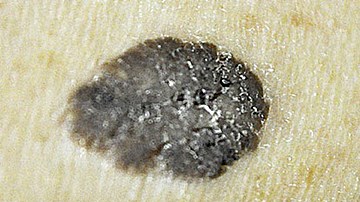 Sometimes, seborrheic keratoses appear as skin growths that look like warts. But, as it grows and develops, it’s clear that this condition is something different. It will either show up completely flat or just slightly elevated. And it can reach up to an inch in diameter in it’s rounded and oval-shaped look. Again, there is no necessary treatment for this condition, though some people do choose to have them removed based on appearances.
Sometimes, seborrheic keratoses appear as skin growths that look like warts. But, as it grows and develops, it’s clear that this condition is something different. It will either show up completely flat or just slightly elevated. And it can reach up to an inch in diameter in it’s rounded and oval-shaped look. Again, there is no necessary treatment for this condition, though some people do choose to have them removed based on appearances.
The most important thing to keep in mind when it comes to seborrheic keratoses is not to bother, or ‘pick at’ the growths. This can lead to bleeding or scabbing, and that can cause the potential for different types of infections. When you do that, you’re essentially turning a harmless skin growth into something far more serious.
Dermatosis Papulosa Nigra
This particular skin growth condition is commonly found amongst African Americans, Polynesians, and Asian cultures. It is characterized as multiple brown or black ‘dots,’ or skin growths on the face and neck. These small growths are smooth, yet firm, yet form in clusters. They tend to be widespread in areas throughout the face and neck.
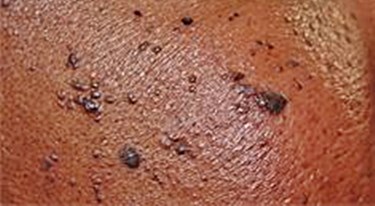 They are considered to be a small version of seborrheic keratoses (see above), though the number of people this condition affects is more concentrated.
They are considered to be a small version of seborrheic keratoses (see above), though the number of people this condition affects is more concentrated.
Dermatosis is highly genetic, above anything else. While conditions like skin tags and warts can come from interaction with people and things, this growth typically comes through genetics alone. They are sometimes referred to as skin growths that look like moles, though they are more raised in nature, and have a slightly different pigmentation than most common moles.
Treatment for Dermatosis Papulosa Nigra isn’t necessarily. In fact, most dermatologists tend to believe you should simply ‘leave them alone.’ This is, of course, unless one of the growths looks irritated or ‘strange’ in some way. Then, a biopsy should be performed to test it. However, these growths are simply a way of life for many people, thanks to genetics, and are harmless.
Freckles
Some people love their freckles, while others wish they could be rid of them. No matter how you feel about freckles there is one thing we can be certain about: They are virtually harmless. Freckles are caused by the sun, in adults. The pigment-creating cells in our bodies are meant to protect us from the sun. When these cells, called melanocytes, are damaged, or someone has less of them, it’s easier for them to change the pigment in our skin, causing freckles.
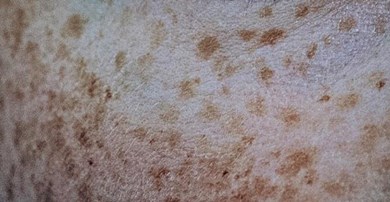 Why do children sometimes have freckles, then? Well, it is likely that they simply have less melanin in their bodies. Children with freckles typically have lighter skin and hair, which is another sign that their bodies don’t produce as much melanin.
Why do children sometimes have freckles, then? Well, it is likely that they simply have less melanin in their bodies. Children with freckles typically have lighter skin and hair, which is another sign that their bodies don’t produce as much melanin.
While freckles are completely harmless in most cases, if you develop them as an adult, it’s likely because you spend quite a bit of time out in the sun, or tanning. Sometimes, this can be harmful to your skin. Freckles on their own won’t cause any damage. However, if you notice other types of spots or a freckle that seems to be ‘inflamed’ at all, it’s a good idea to see a dermatologist quickly. If you never have those problems, accepting your lighter skin, and the freckles that come with it is a great idea!
Liver Spots
Liver spots, also known as age spots, are usually small tan or brown, oval-shaped spots that appear on the arms, face, and hands. They are one of the few skin growths that happen with aging, as they are most commonly found in people who are over 50. However, anyone can speed up the process of their appearance by spending a lot of time in the sun.
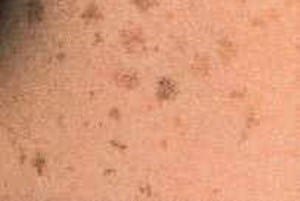 Liver spots are flat, round, and almost ‘faded’-looking in most cases. However, liver spots can be prominent enough to bother some people for cosmetic reasons. Typically, they will occur more often in people who have fairer skin, and more sun exposure that can be damaging. Bleaching or lightening the spots is the most common ‘treatment’ option for those who don’t like the way they look. However, they are otherwise harmless.
Liver spots are flat, round, and almost ‘faded’-looking in most cases. However, liver spots can be prominent enough to bother some people for cosmetic reasons. Typically, they will occur more often in people who have fairer skin, and more sun exposure that can be damaging. Bleaching or lightening the spots is the most common ‘treatment’ option for those who don’t like the way they look. However, they are otherwise harmless.
The only time you should consult a doctor for liver spots is if you notice any rapid changes in the way they look, such as quick growth, irregular borders, or even redness and bleeding. Liver spots are probably more preventable than they are treatable if you protect yourself from the sun most of the time throughout your life. These age spots may not be an immediate threat or a result of any other health issue, but they are a sure sign that your skin has been exposed to too many UV rays throughout your lifetime.
Cherry Angioma
As a skin condition that truly lives up to its name, cherry angioma is often very easy to identify because of its cherry-red color. There is no one known cause for these growths, though there are several common factors that seem to occur with people who get them, including things like genetics, age, and even pregnancy.
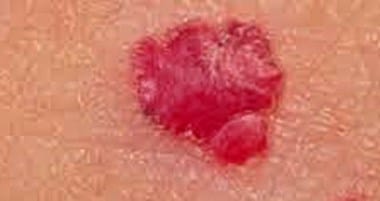 Cherry angioma is usually a bright red, small, round growth that is a group of broken blood vessels under the skin (giving it the red color). They often occur on the arms, shoulders, and back. While they may look intimidating, thanks to that vibrant color, they are typically completely harmless and benign.
Cherry angioma is usually a bright red, small, round growth that is a group of broken blood vessels under the skin (giving it the red color). They often occur on the arms, shoulders, and back. While they may look intimidating, thanks to that vibrant color, they are typically completely harmless and benign.
However, they have similar treatment options to skin tags, should you choose to get them removed for cosmetic purposes. Through surgery, cauterization, or even cryosurgery (freezing), they can often be removed. If you experience any itching or bleeding from these growths, you should see a doctor as soon as possible, especially if you’re unsure of why you are experiencing them in the first place. Your doctor may be able to provide better insight into possible reasons and options. You can get peace of mind by performing a biopsy on any strange-looking growths.
Lipoma
Lipoma is often described as ‘fatty tissue,’ or small benign tumors of the skin. They are not cancerous, and unlike other skin growth possibilities, they do not turn cancerous because of their construction. They are made up of fat cells, just underneath the top layer of skin. These cells form together in a type of ‘capsule,’ causing them to break through the skin’s surface and appear as a sort of soft, small, rubbery growth.
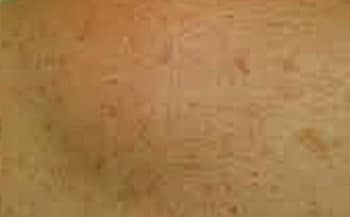 There is no one known cause for Lipoma. Some people believe that because they are made up of fat cells, being overweight is a factor. However, there is no scientific proof backing up that claim. More often than not, they are a result of genetics and hereditary properties.
There is no one known cause for Lipoma. Some people believe that because they are made up of fat cells, being overweight is a factor. However, there is no scientific proof backing up that claim. More often than not, they are a result of genetics and hereditary properties.
Like many other benign skin growths, there is no need to ‘treat’ Lipoma, as it is not painful, and noncancerous. However, some people can be bothered by where it might show up – the face, the neck, etc. If it becomes a cosmetic issue, removing the growth can be as simple as surgery using a local anesthetic. However, unless it appears inflamed, grows rapidly, or starts bleeding, etc., there is no reason to be concerned about having Lipoma in the first place. As far as noncancerous growths go, this soft tissue skin condition is one of the most common.
Milium Cyst
Keratin is a natural protein found in our bodies. However, when there is an abundance of this protein in sensitive areas, it can form what is called a milium cyst. These are small, white, hard bumps typically found somewhere on the face. They are most common in newborns, and young children, though adults are certainly not immune.
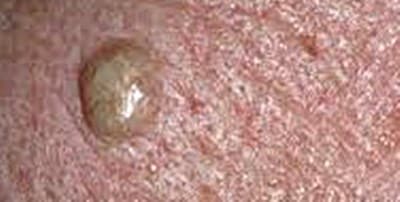 For adults, getting a milium cyst is usually a result of some other skin condition or trauma to the skin. This could include anything from burns to long-term sun damage.
For adults, getting a milium cyst is usually a result of some other skin condition or trauma to the skin. This could include anything from burns to long-term sun damage.
The best part about this particular type of cyst? It will go away on its own, in a matter of weeks. So, there is no real ‘treatment’ necessary. In some cases, if the cysts are painful in any way, your doctor may suggest early removal through something like a skin peel or laser, but these can be somewhat invasive for a skin growth that will go away over time anyway. Milium cysts do not cause long-term damage, and they don’t keep recurring for no reason. If you experience one, you’ll likely recognize it right away due to its location. If you have a child, who experiences one, trust that it will go away shortly, and keep watch with the help of your child’s pediatrician.
Epidermal Inclusion Cyst
Known as the most common type of cyst human beings can get, the epidermal inclusion cyst (EIC) is nothing more than a benign lesion. They typically occur on the face, behind ears, on the top of the head, etc. They can be described as small, hard, round masses underneath the skin, that may even feel like small marbles or beads to some people.
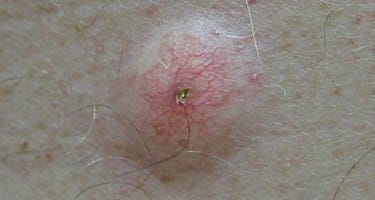 Most EICs are completely benign. However, if you have a cyst that grows, or shows any signs of changing, your doctor may want to keep an eye on it or remove it to perform a biopsy. In some cases, these cysts can become painful. They can also swell, or become inflamed. Some people even experience bursting, in which case it’s important to get the growth checked out. However, for the most part, people simply live with these cysts without any treatment, unless they are blatantly noticeable somewhere on the face.
Most EICs are completely benign. However, if you have a cyst that grows, or shows any signs of changing, your doctor may want to keep an eye on it or remove it to perform a biopsy. In some cases, these cysts can become painful. They can also swell, or become inflamed. Some people even experience bursting, in which case it’s important to get the growth checked out. However, for the most part, people simply live with these cysts without any treatment, unless they are blatantly noticeable somewhere on the face.
Understanding the Different Types of Benign Skin Growths
As you can see, there are plenty of types of benign skin growths. This truly is just the ‘tip of the iceberg’ when it comes to the variety of growths that can occur on the skin. Thankfully, most of these growths are completely harmless, no matter what. And, because they are easy to spot with a little self-checking, you can monitor them on your own, without having to consult a doctor unless something changes.
Sometimes, we don’t know what causes particular skin growths. Some are more obvious than others, and some remain a bit of a mystery as far as the actual cause. Personal, cosmetic choices are often the biggest decision people have to make when it comes to their skin growth treatment and whether or not you want to remove it. Now that you know a bit more about different types of skin growths, possible causes, and what to look for, you can be more aware of how to handle them throughout the rest of your life.
